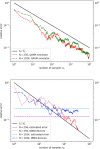Hybrid classical-quantum linear solver using Noisy Intermediate-Scale Quantum machines
- PMID: 31700001
- PMCID: PMC6838121
- DOI: 10.1038/s41598-019-52275-6
Hybrid classical-quantum linear solver using Noisy Intermediate-Scale Quantum machines
Abstract
We propose a realistic hybrid classical-quantum linear solver to solve systems of linear equations of a specific type, and demonstrate its feasibility with Qiskit on IBM Q systems. This algorithm makes use of quantum random walk that runs in [Formula: see text](N log(N)) time on a quantum circuit made of [Formula: see text](log(N)) qubits. The input and output are classical data, and so can be easily accessed. It is robust against noise, and ready for implementation in applications such as machine learning.
Conflict of interest statement
The authors declare no competing interests.
Figures




References
-
- Nielsen MA, Chuang IL. Quantum Computation and Quantum Information: 10th Anniversary Edition. 10th edn. New York, NY, USA: Cambridge University Press; 2011.
-
- Golub GH, Van Loan CF. Matrix Computations (3rd Ed.) Baltimore, MD, USA: Johns Hopkins University Press; 1996.
-
- Saad Y. Iterative Methods for Sparse Linear Systems. 2nd edn. Philadelphia, PA, USA: Society for Industrial and Applied Mathematics; 2003.
Grants and funding
- MOST 107-2627- E-002 -001 -MY3/Ministry of Science and Technology, Taiwan (Ministry of Science and Technology of Taiwan)
- MOST 106-2221-E-002 -164 -MY3/Ministry of Science and Technology, Taiwan (Ministry of Science and Technology of Taiwan)
- MOST 108-2628-E-002 -010 -MY3/Ministry of Science and Technology, Taiwan (Ministry of Science and Technology of Taiwan)
LinkOut - more resources
Full Text Sources

